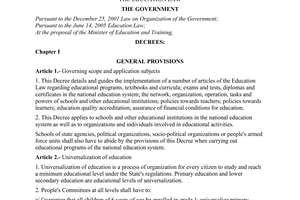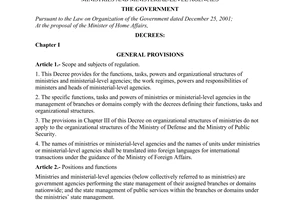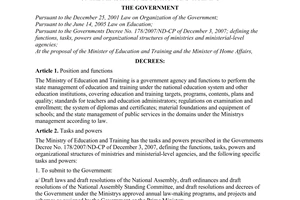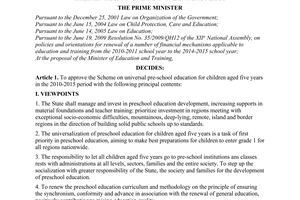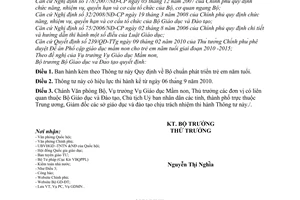Nội dung toàn văn Circular No. 23/2010/TT-BGDDT on introduction of 5-year-old child growth standards
|
MINISTRY OF
EDUCATION AND TRAINING |
THE SOCIALIST
REPUBLIC OF VIETNAM |
|
No. 23/2010/TT-BGDDT |
Hanoi, July 23, 2010 |
CIRCULAR
ON INTRODUCTION OF 5-YEAR-OLD CHILD GROWTH STANDARDS
Pursuant to the Government's Decree No. 178/2007/ND-CP dated December 03, 2007 defining the functions, rights, responsibilities and organizational structure of Ministries and ministerial agencies;
Pursuant to the Government's Decree No. 32/2008/ND-CP dated March 19th 2008, defining the functions, rights, responsibilities and organizational structure of the Ministry of Education and Training;
Pursuant to the Government's Decree No. 75/2006/ND-CP dated August 02, 2006, elaborating and providing guidance on the implementation of a number of articles of the Law on Education;
Pursuant to the Decision No.239/QD-TTg dated February 09, 2010 on approval for the educational universal to 05-year-old children for the period 2010 – 2015;
Upon request of the Director of the Department of Preschool Education,
The Minister of Education and Training hereby decides:
Article 1. To promulgate 5-year-old child growth standards enclosed herewith.
Article 2. This Circular comes into effect from September 06, 2010.
Article 3. The Chief of the Ministry Office, Directors of Departments of preschool Education, heads of affiliates to the Ministry of Education, Presidents of People’s Committees of provinces and Directors of Departments of Education and Training shall be responsible for implementation of this Circular ./.
|
|
PP.MINISTER |
REGULATION
ON 05-YEAR-OLD CHILD GROWTH STANDARDS
(Issued together with the Circular No.23/2010/TT-BGDDT dated July 23, 2010 by
the Minister of Education and Training)
Chapter I
GENERAL PROVISIONS
Article 1. Scope and subjects of application
1. This Circular provides for the 5-year-old child growth standards, including the contents of the -year-old child growth standards, and responsibilities of education authorities and preschools.
2. This Circular applies to preschools, kindergartens and kindergartens classes of the national education system.
Article 2. Structure of 05-year-old child growth standards
1. The 05-year-old child growth standard include 04 areas, 28 standards and 120 indicators
2. It is structured as follows:
a. Areas of development constituted by standards
b. Standards constituted by indicators
Article 3. Interpretation
For the purposes of this Circular, terms herein shall be construed as follows:
1. 5-year-old child is any child aged from 60 months to 72 months.
2. Area of development is a specific scope of development.
3. Standard is any expectation that a 05-year-old child recognizes and is able to do some specific things.
4. Indicator is the specification of standards and description of child’s behaviors and skills.
Article 4. Purpose of introduction of 05-year-old Child Growth Standard
1. Support the implementation of the preschool’s education programs, improve the quality of care and education of 05-year-old children and prepare them for grade 1.
a) Serve as the basis for providing objectives, care and education contents in details, selecting and modifying care and education activities where suitable for 05-year-old children.
b) Lay a foundation for the development of toolkit for monitoring and monitoring the growth of 05-year-old children at the preschool age.
2. Give the ground for development of guidance documents and programs on care and education of 5-year-old children in order to increase the parents and community’s awareness of child growth
Chapter II
CONTENTS OF 5-YEAR-OLD CHILD GROWTH STANDARD
Article 5. Standards in the physical growth area
1. Standard 1. The child is able to control and coordinate his/her own large motor muscle groups
a) Indicator 1. Make a standing long jump of at least 50 cm.
b) Indicator 2. Make a jump from the height of 40 cm;
c) Indicator 3.Throw and catch balls with two hands from the distance of 04 m;
d) Indicator 4.Go up and down stairs at the height 1.5m from the floor.
2. Standard 2. The child is able to control and coordinate his/her own small motor muscle groups
a) Indicator 5. Put on and take off his/her clothes on his/her own;
b) Indicator 6. Color properly and inside the line;
c) Indicator 7. Cut along straight and curved lines of simple shapes;
d) Indicator 8.Properly adhere shapes to the designated position.
3. Standard 3.The child is able to use his/her senses and keep balanced while moving
a) Indicator 9. Hop on each foot at least consecutive 5 times and change the foot upon request;
b) Indicator 10.Smash and catch balls with 02 hands;
c) Indicator 11. Do balance jogging exercises on chairs (2m x 0.25m x 0.35m).
4. Standard 4.The child is able to show his/her strength, agility, endurance and flexibility
a) Indicator. Run a distance of 18 meters in 5 -7 seconds
b) Indicator 13. Run a distance of 150 meters without stop in an unlimited time;
c) Indicator 14.Continously study for approximately 30 minutes with no signs of fatigue
5. Standard 5. The child is gain some certain knowledge about personal hygiene and nutrition and is able to apply to reality
a) Indicator 15. Wash hands with soap before (s)he eats food, after (s)he goes to toilet and when the hands are visibly dirty;
b) Indicator 16. Daily wash his/her face and brush his/her own teeth;
c) Indicator 17. Cover his/her mouth when (s)he coughs, sneezes and yawns;
d) Indicator 18. Keep his/her hair and clothes neat and tidy;
dd) Indicator 19. Name some necessary foods on daily meals;
e) Indicator 20. Identify and Stay away from some foods and beverages which are harmful to people’s health
6. Standard 6. The child develops sense and practice of personal security
a) Indicator 21. Identify and keep himself/herself away from some dangerous objects;
b) Indicator 22. Recognize and avoid dangerous things;
c) Indicator 23.Avoid playing at dirty and dangerous places;
d) Indicator 24. Avoid following and receiving gifts from strangers without the permission of relatives;
dd) Indicator 25. Know how to call for help and run away from dangerous places;
e) Indicator 26. Know the harmful effects of smoking and stay away from smokers.
Article 6. Standards in emotional and social relation development
1. Standard 7.The child develops a sense of self
a) Indicator 27.Communicate certain important information on himself/herself and his/her family;
b) Indicator 28. Learn his/her gender and act accordingly;
c) Indicator 29. Express his/her personal interests and skills
d) Indicator 30. Suggest games and activities in which (s)he shows personal interests.
2. Standard 8. The child believes in his/her abilities
a) Indicator 31. Show perseverance on challenging assignments;
b) Indicator 32. Show his/her pleasuring in completing something
c) Indicator 33. Be actively involved in some simple chores;
d) Indicator 34.Confidently express his/her own opinions.
3. Standard 9. The child is able to recognize and express his/her feelings
a) Indicator 35.Understand people’s emotional states such as happiness, sadness, surprise, anger and shame;
b) Indicator 36. Express his/her own feelings by using verbal languages, gestures and facial expressions;
c) Indicator 37.Share the joys and give consolation to his/her friends and relatives;
d) Indicator 38. Show the interests in the beauty;
dd) Indicator 39. Be interested in growing trees and familiar domestic animals;
e) Indicator 40.Change his/her behaviors and attitude according to the circumstances;
g) Indicator 41.Be able to control his/her own bad temper after receiving explanations and consolation.
4. Standard 10. The child has friendly relations with his/her friends and adults
a) Indicator 42. Socialize with his/her friends;
b) Indicator 43.Proactively communicate with close friends and adults;
c) Indicator 44.Like to share feelings, experiences, toys and belongings with closed people.
d) Indicator 45. Be willing to help people facing difficulties;
e) Indicator 46. Have cohesive groups of friends;
g) Indicator 47. Stand in line while participating in activities.
5. Standard 11. The child has a cooperative attitude towards surrounding people and friends
a) Indicator 48.Listen to other people;
b) Indicator 49. Exchange opinions with friends;
c) Indicator 50. Show the friendliness and solidarity with friends;
d) Indicator 51.Accept assignment by adults or groups of friends;
dd) Indicator 52. Be willing to cooperate with other people in fulfillment of simple tasks.
6. Standard 12. The child has proper behavior according to code of conduct
a) Indicator 53.Be aware of the impacts of his business on others;
b) Indicator 54. Form a habit of greeting, apology, and gratitude and use politely vocative expression to adults;
c) Indicator 55. Ask for others’ help if necessary;
d) Indicator 56. Be able to comment on right or wrong behaviors towards the environment;
dd) Indicator 57.Have pro-environmental behaviors in daily activities.
7. Standard 13. Treat other people with respect
a) Indicator 58. Be able to talk about friends and relatives ‘abilities and interests;
b) Indicator 59.Accept the fact that the difference between him/her and other people exists;
c) Indicator 60.Be concern about fairness among friends.
Article 7.Standards in language and communication development
1. Standard 14. The child is able to hear and understand spoken words
a) Indicator 61.Understand the nuances of voices such as happiness, sadness, anger, , surprises and fear;
b) Indicator 62.Understand and follow instructions related to 2, 3 actions
c) Indicator 63. Understand a number of general words referring to simple and familiar things and phenomena;
d) Indicator 64.Understande stories, poems, folk songs for kids and children’s songs.
2. Standard 15. The child is able to verbally communicate
a) Indicator 65.Speak clearly;
b) Indicator 66. Be able to use expressive language to name things, describe actions and feelings
c) Indicator 67.Use various types of sentences in communication;
d) Indicator 68.Verablly express feelings, needs, opinions and experiences;
dd) Indicator 69. Verbally exchange opinions and give instructions to friends;
e) Indicator 70.Be able to talk about an event or phenomenon;
g) Indicator 71. Tell stories in proper sequences;
h) Indicator 72.Find out how to strike up conversations
3. Standard 16.The child is able to follow several common codes of conduct for communication
a) Standard 73.Adjust voice volume according to the communication demand and circumstances;
b) Indicator 74.Listen intently and respond with proper gestures, eye and facial expression;
c) Indicator 75.Avoid interrupting others;
d) Indicator 76. Ask for explanations where (s)he does not understand something or express via gestures and facial expressions;
dd) Indicator 77.Use words conveying the meaning of greeting and politeness according to situations;
e) Indicator 78. Avoid using bad languages.
4. Standard 17. Be interested in reading
a) Indicator 79.Be interested in reading words presented in the surrounding environment;
b) Indicator 80.Express interest in books;
c) Indicator 81.Preserve books
5. Standard 18. The child shows initial acts of reading
a) indicator 82. Understand the meanings of some signs and symbols;
b) Indicator 83.Imitate acts of a reader;
c) Indicator 84.Repeat comics that (s)he already known;
d) Indicator 85.Tell photo stories
6. Standard 19.The child shows primary understandings of writing
a) indicator 86.Be aware that words may be read and may replace speaking;
b) Indicator 87. Be able to use symbols to pictures to show his/her feelings, needs, thinking and experiences;
c) Indicator 88. Imitate acts of writing and copying of words and letters;
d) Indicator 89.Write down his/her name in his/her own way;
dd) Indicator 90. Be able to write letters from left to right and then from top to bottom
e) Indicator 91. Identify letters in the Vietnamese alphabet.
Article 8.Standards in cognitive development area
1. Standard 20.The child shows understanding of the natural environment
a) Indicator 92. Name categories of trees and animal by common characteristics;
b) Indicator 93.Recognize changes in the process of growth of trees, animal and natural phenomenon;
c) Indicator 94. Describe several outstanding characteristics of seasons in his/her places;
d) Indicator 95. Forecast several imminent natural phenomena.
2. Standard 21.The child shows understanding of the social environment
a) Indicator 96.Classify common belongings by its material and function;
b) Indicator 97. Name several public places in the vicinity of his/her places;
c) Indicator 98. Specify common occupations in his/her place.
3. Standard 22. The child shows some understanding of music and graphics
a) Indicator 99. Identify melodies of songs or tracks;
b) Indicator 100. Sing the correct melody of children songs;
c)Indicator 101.Express proper feelings and make movement according to rhythm of song or tracks;
d) Indicator 102. Make simple products from various materials;
dd) Indicator 103. Present concepts of his/her shaped products.
4. Standard 23. The child has some understanding of numbers, ordinal numbers and measurement units
a) Indicator 104. Identify numbers equivalent to the quantity within the range of 10;
b) Indicator 105. Divide 10 objects into 02 groups by 02 different ways and compare the quantity of objects in these two groups;
c) Indicator 106. Be able to measure the length of things and report the measurement results.
5. Standard 24. The child is able to identify geometric shapes and has spatial orientation
a) Indicator 107. Name the sphere, square, rectangular and cylinder upon request
b) Indicator 108. Position an object relative to another (inside, outside, above, below, behind, in front of, right and left).
6. Standard 25. The child is able to priliminarily identify time
a) Indicator 109. Name the days of the week by their order;
b) Indicator 110.Diferentiate between yesterday, today and tomorrow according to daily events
c) Indicator 111.Identify the hours on the clock and days on calendar.
7. Standard 26. The child is curious and stay excited about learning
a) Indicator 112. Like to ask questions;
b) Indicator 113. Show an interest in discovering surrounding things and phenomena
8. Standard 27.The child shows his/her reasoning skills
a) Indicator 114. Explain simple cause - effect relationships in everyday life
b) Indicator 115.Identify objects different from others;
c) Indicator 16.Realize simple rules for arrangement of things and follows them.
9. Standard 28.The child show his/her creativity;
a) Indicator 117. Rename objects, titles of stories and lyrics of songs;
b) Indicator 118. Do some tasks in his/her own ways;
c) Indicator 119.Express his/her own ideas through various activities;
d) Indicator 120.Narrate familiar stories in a different ways.
Chapter III
RESPONSIBILITIES OF EDUCATION AUTHORITIES AND PRESCHOOLS
Article 9. Responsibilities of Departments of Education and Training
According to the 5-year-old child growth standard issued by The Ministry of Education and Training, the Departments of Education and Training shall direct the Divisions of Education and Training to implement according to the reality.
Article 10. Responsibilities of Division of Education and Training
Divisions of Education and Training of districts shall develop inspection plans and guidance and carry out the inspection of the implementation of the 5-year-old child growth standard.
Article 11. Responsibilities of preschools, kindergartens and independent kindergarten classes
According to the Division of Education and Training’s guidance , the preschools, kindergarten and independent kindergarten classes shall apply the 05-year-old child growth standard according to the reality.
------------------------------------------------------------------------------------------------------
This translation is made by LawSoft and
for reference purposes only. Its copyright is owned by LawSoft
and protected under Clause 2, Article 14 of the Law on Intellectual Property.Your comments are always welcomed
